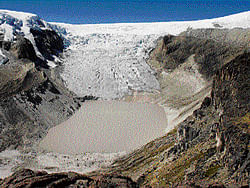
Glaciers in the Andes are melting. Proof of this lies in the fact that rapid melting at the margins of Peru’s Quelccaya ice cap, the world’s largest tropical ice sheet, is uncovering plants that were in a deep freeze, writes Justin Gillis.
Glacial ice in the Peruvian Andes that took at least 1,600 years to form has melted in just 25 years, scientists reported recently, the latest indication that the recent spike in global temperatures has thrown the natural world out of balance. The evidence comes from a remarkable find at the margins of the Quelccaya ice cap in Peru, the world’s largest tropical ice sheet. Rapid melting there in the modern era is uncovering plants that were locked in a deep freeze when the glacier advanced many thousands of years ago.
Dating of those plants, using a radioactive form of carbon in the plant tissues that decays at a known rate, has given scientists an unusually precise method of determining the history of the ice sheet’s margins. Lonnie G Thompson, the Ohio State University glaciologist whose team has worked intermittently on the Quelccaya ice cap for decades, reported the findings in a paper released online by the journal Science.
The paper includes a long-awaited analysis of chemical tracers in ice cylinders the team recovered by drilling deep into Quelccaya, a record that will aid scientists worldwide in reconstructing past climatic variations. Such analyses will take time, but Thompson said preliminary evidence shows, for example, that the earth probably went through a period of anomalous weather around the time of the French Revolution, which began in 1789.
The weather presumably contributed to the food shortages that exacerbated that upheaval. “When there’s a disruption of food, this is bad news for any government,” Thompson said in an interview. Of greater immediate interest, Thompson and his team have expanded on previous research involving long-dead plants emerging from the melting ice at the edge of Quelccaya, a huge, flat ice cap sitting on a volcanic plain 18,000 feet above sea level.
Plants from the past
Several years ago, the team reported on plants that had been exposed near a meltwater lake.
Chemical analysis showed them to be about 4,700 years old, proving that the ice cap had reached its smallest extent in nearly five millenniums.
In the new research, a thousand feet of additional melting has exposed plants that laboratory analysis shows to be about 6,300 years old. The simplest interpretation, Thompson said, is that ice that accumulated during approximately 1,600 years melted back in no more than 25 years. “If any time in the last 6,000 years these plants had been exposed for any five-year period, they would have decayed,” Thompson said. “That tells us the ice cap had to be there 6,000 years ago.”
Meredith A Kelly, a glacial geomorphologist at Dartmouth College who trained under Thompson but was not involved in the new paper, said his interpretation of the plant remains was reasonable. Her own research on Quelccaya suggests that the margins of the glacier have melted quite rapidly at times in the past. But the melting now under way appears to be at least as fast, if not faster, than anything in the geological record since the end of the last ice age, she said.
Global warming, which scientists say is being caused primarily by the human release of greenhouse gases, is having its largest effects at high latitudes and high altitudes. Sitting at high elevation in the tropics, the Quelccaya ice cap appears to be extremely sensitive to the temperature changes, several scientists said. “It may not go very quickly because there’s so much ice, but we might have already locked into a situation where we are committed to losing that ice,” said Mathias Vuille, a climate scientist at the State University at Albany in New York.
Throughout the Andes, glaciers are now melting so rapidly that scientists have grown deeply concerned about water supplies for the people living there.
Glacial meltwater is essential for helping Andean communities get through the dry season. In the short run, the melting is producing an increase of water supplies and feeding population growth in major cities of the Andes, the experts said. But as the glaciers continue shrinking, trouble almost certainly looms. Douglas R Hardy, a University of Massachusetts researcher who works in the region, said, “How much time do we have before 50 per cent of Lima’s or La Paz’s water resources are gone?”